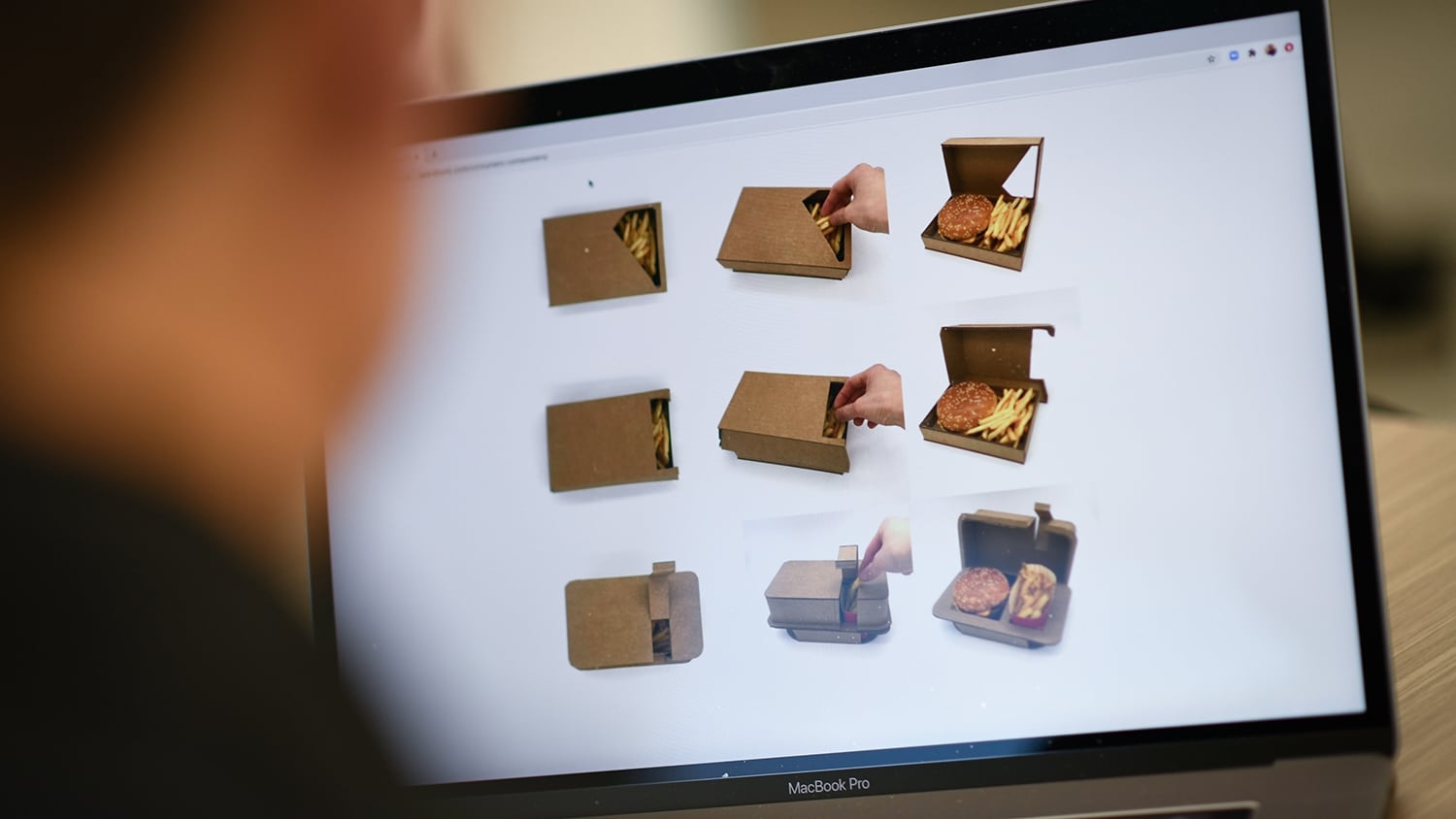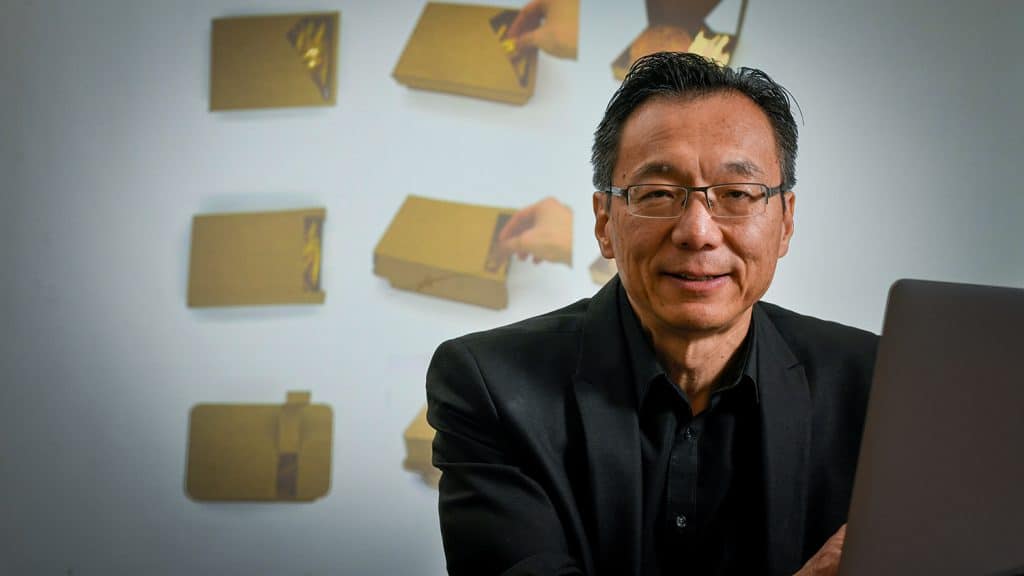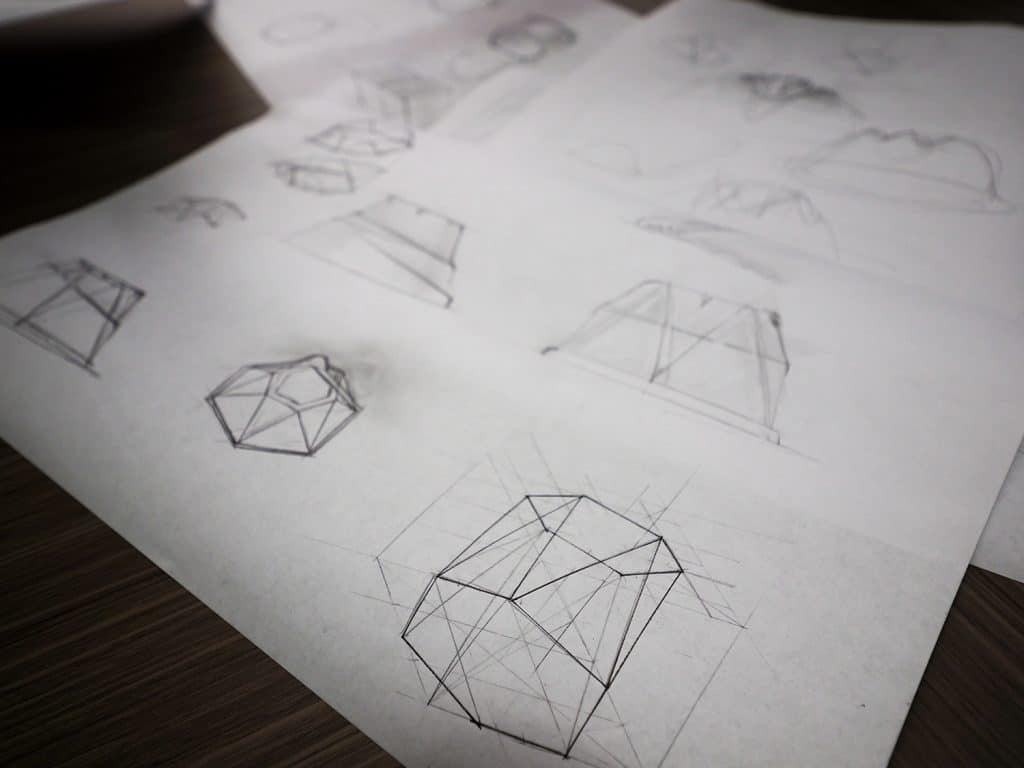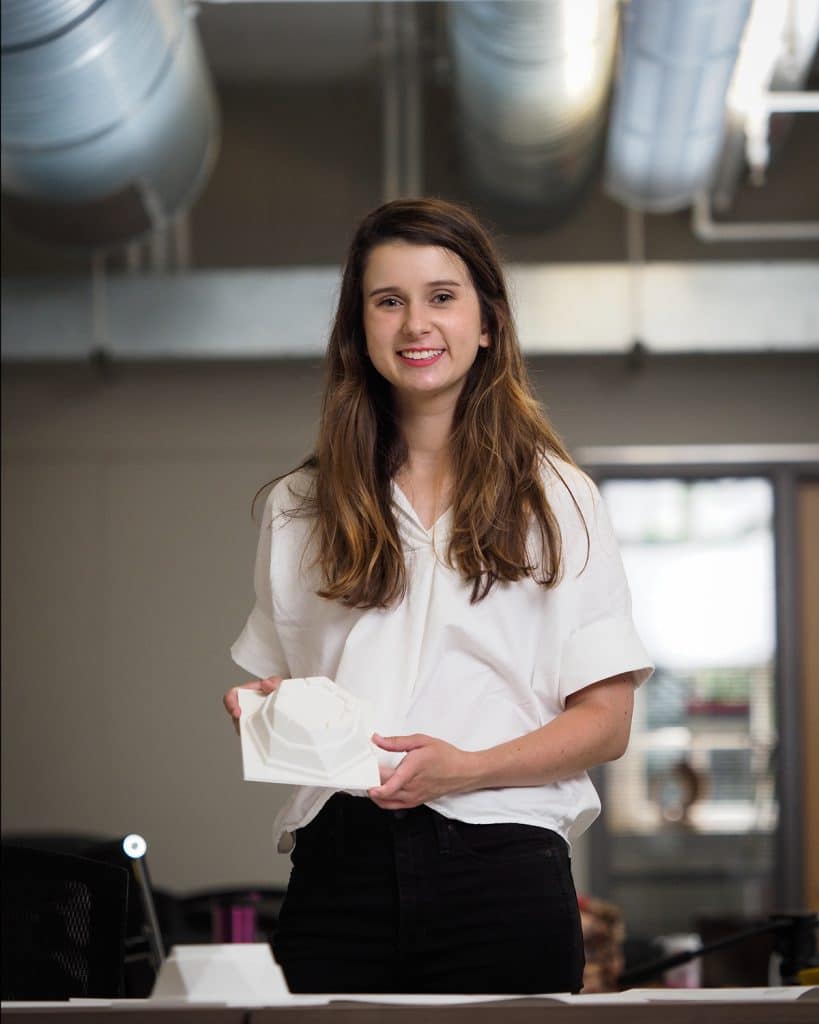Design Students Develop Compostable Take-Out Container Prototypes in Project Sponsored by Eastman

Take-out food has been a culinary staple for decades, but traditional plastic and foamed polystyrene containers end up in landfill and are not sustainable. To combat packaging waste, NC State’s College of Design worked alongside Eastman to create environmentally friendly food packaging using a new compostable material.
Eastman enlisted the College of Design to transform a new biodegradable and compostable material the company had created. Senior industrial design students created take-out containers with the entire supply chain in mind — containers that are easy to assemble, pack, eat from and dispose of. The end result promises added sustainability in the restaurant industry.
“This project really is about bringing sustainability to a market that has been overlooked for many years,” said Tsai Lu Liu, the head of the Department of Graphic Design and Industrial Design at NC State’s College of Design. “People go to a restaurant, bring home food and consume the food. Maybe you use the package for 20 or 30 minutes, and the next thing you know it goes into the trash can. Then it becomes an issue to the environment. We really see the potential to make a difference, to make food packaging more sustainable.”

The material itself is derived from the cellulose of sustainably managed trees, a naturally biodegradable material. However, it looks and feels like traditional plastic. These properties mean the product is certified industrial and home compostable* but maintains the ease and hygiene consumers prefer in single-use articles. Replacing traditional plastics with compostable products helps protect the environment and our world.
“Entirely too many single-use plastics are ending up on the side of the road, in waterways, and even in landfills where they’ll just persist for hundreds of years,” said Lizz Sapia, Eastman’s Growth Process Steward Center of Excellence manager. “Current plastics aren’t a viable long-term option, but single-use plastics are here to stay from a consumer ease and hygiene perspective. Consumers love their plastics, but the research shows that they’re also concerned about the ultimate fate of these materials. The project with NC State looked at redesigning those single-use articles from a different material, one that’s compostable and has a better end-of-life story without compromising the consumer experience.”
The project came at an opportune time: All work was completed during the 2018-2019 academic year, before the COVID-19 pandemic reached the United States in 2020. The pandemic made to-go food even more important for eaters and restaurateurs, as dining rooms closed to protect public health. Take-out became one of the only ways to support local businesses as the coronavirus raged on.
“I love working with students because of the creativity and the natural passion they have for the projects they’re working on,” added Sapia. “They have such great questions because they’re genuinely excited about the materials, the design process and, most importantly, the why behind the project.
Designing for People and Planet
Thorough research was needed before creating the packaging. Students interviewed those who manufacture the packaging, those who would handle and pack the take-out containers — like restaurant workers — and those who would eat from them.
“The surprising thing about the project was the different layers of who would be using the product,” said Kevin Milz, a student in the Master’s of Industrial Design program. “There’s Eastman, and then there’s Eastman’s customers — the fast food industry, which would be using these products. Then you’ve got to think of the people handling it — the restaurant employees — and how efficiently they can use this. Then you’ve got the end user, who is the person actually receiving the product. We had to think of all of these different levels.”

Liu agreed, explaining: “At first you think, ‘Oh, packaging food, it’s a very simple mechanism — it’s just boxes.’ But then when we went deeper, we realized even the little details, the relationship between the materials and the people’s experience, there are a lot of areas we can improve.”
Hands-on Learning
Senior design projects are a vital experience for many NC State students. Companies sponsor the projects, which students complete during the academic year. These projects weave together academia, industry, research and innovation. Students take on a practical, hands-on learning experience that bolsters their skills and prepares them for the workforce. Companies benefit from students’ fresh perspectives and insight into new technologies.
Eastman’s project builds upon a culture of sustainability at NC State. In a senior design project sponsored by Under Armour, four students in the Wilson College of Textiles developed a nonwoven material that incorporated down insulation waste. Short fibers that remain after processing down often end up in landfills. The students identified how to control down material in facilities and use it in a nonwoven material. They then developed a puffer jacket prototype for Under Armour using the more sustainable material.
“If you think it can’t be done, you should give it to a student because they don’t know that it can’t be done,” said Dawn Mason, Global External Innovation Manager at Eastman.
A Model for University-Industry Partnerships
This isn’t the first breakthrough developed between the company and university. Results over the last eight years include 63 co-op students, 35 full-time hires and 34 invention disclosures. Eastman has invested $19 million across 11 academic departments, funding more than 100 research projects that benefit student and faculty development while advancing innovation within the company. Eastman and NC State signed a master research agreement in 2012 to streamline collaborations and in 2019 renewed it for another six years.
“For us, the partnership really is special,” said Mason. “It really helps us inform and accelerate our innovation platforms. Over the years, we have developed what you would expect to have in a partnership versus just a supplier-customer sort of relationship. It’s much deeper than that.”
In 2012, Eastman chose NC State as a strategic partner after a nationwide search, citing the university’s leadership in partnerships — the flexibility needed to work with industry, the ability to solve real-world problems and unique assets like Centennial Campus, where today Eastman’s innovation center is located steps away from NC State’s main campus. Through the partnership, NC State students gain hands-on experience, and collaborations with faculty advance interdisciplinary research across the university.
“Eastman is the gold standard when it comes to impactful university-industry collaborations,” said NC State Associate Vice Chancellor for Partnerships Mark Schmidt. “NC State is committed to partnerships that help solve societal challenges while developing students who are prepared for the future.”
Preparing Students for the Future
Embodying NC State’s motto of “Think and Do,” the food packaging project gave industrial design students insight into what type of career they might pursue. Students developed technical skills in design and manufacturing as well as marketing and research skills. As they prepared to enter the workforce, students also got to learn from and network with Eastman professionals.
“The reason I got into this program in general was to be able to have an opportunity to make connections with service projects or with different sponsored projects, like the one we were doing with Eastman,” Milz said. “You get to see real world projects that affect other people versus just designing for ourselves.”
Madelyn Lammert, a student in the Master’s of Industrial Design program, said she learned numerous lessons from working on the project, both theoretical and concrete. For example, people often pay more for products with well-designed packaging. And as someone who wants to make sustainability part of her career, Lammert said she gained valuable experience from the project.
“I think this project was really impactful in terms of learning about the user research journey for design and helping create something that’s actually going to be impactful on the world,” she said.

By working directly with industry partners, students gain an experiential opportunity that only enhances their education.
“Our faculty do a really good job of instructing our students, but to have it echoed by an industry sponsor, in a professional level project, that’s when it really starts to sink in,” said Timothy Buie, an associate professor of industrial design. “Eastman aligns very well with us in that regard.”
“In addition to the sustainability side of the project, it also highlights Eastman’s commitment to our partnership with NC State,” Sapia added. “We love collaborating with the university.”
*Certified BPI Industrial Compostable ≤10 mil film and 8 mil straw, ≤36 mil high-density foam; TŪV AUSTRIA-certified Industrial Compostable ≤10 mil film and ≤32 mil high-density foam; TŪV AUSTRIA-certified Home Compostable up to 7 mil straw and up to 32 mil foam
- Categories: